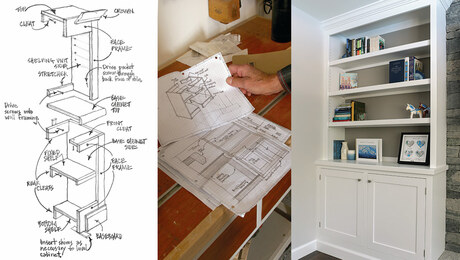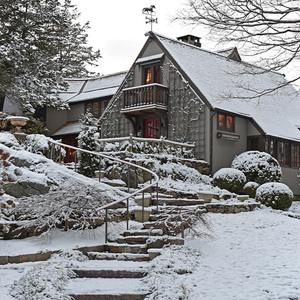*
in an effort to save a few bucks i am looking for a light weight steel
truss design to “copy” from. single slope-as low as possible, just enough
to keep water from ponding, no snow load to factor in-it does snow here.
i need to span 32 feet. if i should go to a engineer, what is a
resonable price to pay for plans? i also need to build these on site
like a stick builder. any idea’s. thank you in advance
Discussion Forum
Discussion Forum
Up Next
Video Shorts
Featured Story

A standardized approach, quick-to-install hardware, and a simplified design make building custom casework cost-effective.
Highlights
"I have learned so much thanks to the searchable articles on the FHB website. I can confidently say that I expect to be a life-long subscriber." - M.K.














Replies
*
Marty, I've seen magazine ads for a steel truss piece made by Dietrich Industries. It looks like it is the ridge piece with short sections of channel to screw your steel studs into. Don't know anything else about them but they call their floor system TradeReady & I think the ad I'm thinking of had the floor system in the same picture. How's this for not much help? Joe H
*I have no idea what you're building or why you want to use steel but you can't possibly get anything cheaper than buying regular old wood roofing trusses. I don't even think you could build your own as cheap as you can buy them.
*Marty,I suggest you check with demolition companies. Web steel trusses are common in commercial construction and they may have what you need in their yard. You may have to buy some that are are longer than you need but web steel trusses will be easier to modify than something made out of wood. Considering the minimum amount of pitch you are looking for I would make one wall a couple of inches higher and use flat trusses. They will be significantly cheaper. Do not attempt to fabricate them yourself. The companies that make these things can sell you welded up and painted units cheaper than you can buy the materials. Design consideration: While most wood trusses sit on top of the wall plate web steel trusses are usually "hung". The top runner is longer than the bottom runner which fits down between the walls. Make sure you allow for this when establishing wall heigth. If you are committed to building on site consider wood.
*There are a lot of wood truss manufacturers who can now build lightweight steel trusses. You might ask around.
*Wood sucks. Go with steel. It's recycleable, inexpensive, termites don't eat it, you can cut it off 3 times and if it's still too short you can weld a piece back on, the same piece is the same damn size from day to day weather it's raining or not and out of a pile big enough to frame my 3 story Victorian I didn't find one damn knot,check,split,crack,crown,warp or twist! (Wood sure is pretty though, just use it for decoration).And by the way, you can grow "steel trees" 32 feet high all day long or longer. You may not need to build or buy trusses at all. You need to get your particular application blessed by an engineer, but I bet you can span that 32 feet with cold formed light gage steel joists in something like a 2x10x16gage or 14gage. My floor joist are all 40' long 2x12x18 (continuous lengths but not clear spans) on 24" centers. My engineer (and me) were very impressed with the lack of deflection compared to his new wood framed house. My trusses are light gage steel as well, fabricated by a local company here in Jacksonville. They were light enough for me and a couple friends to haul up by hand. Some I did myself. My inspiration came from Fine Homebuilding but a lot of my technical info came from American Iron and Steel Institutehttp://www.steel.org/. They may have span tables by now.
*Bob, I am intrigued by the new lightweight steel systems. I'm sure I will have to adapt to it before I retire. I like the uniformity that can be built into the steel systems.Do you think it was faster, slower, or equal to a wood framed system?What are the drawbacks?blue
*Blue, Honestly, it is slower for a couple reasons:1 cutting and 2 fastening.1) Cutting requires a chopsaw, makes a lot of sparks and just takes a little longer than wood. The good news is that you can order pieces to exact lengths to minimize cutting, make sure you tell your supplier to hold the tolerance though. There are some portable shears available for lopping off drywall studs (20 gage to 26 gage). 2)Primarily, fastening is made by self drilling screws. Obviously, this takes longer than a nail gun. Clamps have to be used often to hold pieces together while fastening, at least until you develop your own "technique" or feel for avoiding this. In the case of my own house most of the framing is welded together. I was once a welder so this was kinda natural for me. I wanted the extra strength plus it gave me more flexibility in my joint designs. In other words, I could make straight cuts and just butt two pieces together and weld rather than fashion a more intricate lap for screws.I touched up galvanize with Zinc-rich paint.There are a couple other considerations when using steel also: the webs of joist (the flat part in the middle between flanges)has to be stiffened with blocking at bearing points, depending on your climate, heat transfer may be an issue, insulation bats have to be wider than for wood. Many local building codes don't address light gage steel, you'll probably need an engineers stamp on everything. You can't run to any hardware store for an 18 gage stud. Most home centers carry 25 gage (partition wall only). There are a lot more supply houses out there now though that can get a full line of steel. Sometimes wood is cheaper. The price of steel doesn't fluctuate nearly as bad as wood. When I bought steel, Hurricane Andrew had gone through and wood was through the roof(no pun intended). That's generally when interest in steel framing escalates, then subsides again as wood prices diminish again. The forward thinking builders I know in my area have used steel and other alternative materials, but they must follow the market. When wood is cheaper, they use it unless the customer understand the value and strength of steel. Unfortunately, the average housewife (or househusband) wants square footage and a fashionable facade and don't care if it's framed with popsicle sticks.All these drawbacks can be overcome with planning and practice. To me, the benefits outweigh the shortcomings. I could go on and on...It doesn't mildew, warp or rot if it gets rained on...instead of using 4 wood king studs to support a header use one of higher grade steel of the same size as any other stud...one man can carry a whole stack of studs...get paid a few pennies for your scrap instead of paying to dispose of...I'm a little biased toward steel, as you can tell, largely because most of my work experience has been in welding and ship repair industry. I do have building experience in wood but it has never been a profession. Fine Homebuilding issue 95 April/May, 1995 article "Framing with steel for the first time" gives a perspective from a "wood framer". http://www.taunton.com/fh/admin/toc/95.htm That's enough of a mouthful for now I think.
*I thought of one more drawback with steel framing I have to mention. Attaching trim with finish screws is a big pain in the neck.
*Thanks for the detailed reply Bob. I am familiar with steel framing in commercial renovation work, but have never used any of it in residential framing. I have used it in remodeling too. I also have a history of welding. I worked in a structural steel supply company for three years. I never liked welding galvanizedsteel. Isn't most steel galvanized? Do you arc weld steel studs, or use a wire feed (I've never used a wirefeed)?blue
*I accomplished most of the welding of the light gage materials with an inexpensive wire feed welder from Home Depot. It is a Cambel Hausfeld 115 volt unit capable of a maximum output of about 80-100 amps. The steel wire has a flux core allowing welding of steel without additional gas shielding. It's great for welding thin stuff because the amperage can be set very low. 115 volt welders are very sensative to voltage drop. They need maximum input power for stability and efficient duty cycle. When used with long extension cords the job slows down. They are quite easy to master,not nearly as technique dependant as stick welding. My son was welding studs with few lessons at age 11. Welding through heavy galvanized coating is indeed a pain and, in fact, can make you very sick. The thin galvanize on steel studs was not a factor. I would recommend using a respirator particularly when welding in enclosed spaces.
*
in an effort to save a few bucks i am looking for a light weight steel
truss design to "copy" from. single slope-as low as possible, just enough
to keep water from ponding, no snow load to factor in-it does snow here.
i need to span 32 feet. if i should go to a engineer, what is a
resonable price to pay for plans? i also need to build these on site
like a stick builder. any idea's. thank you in advance